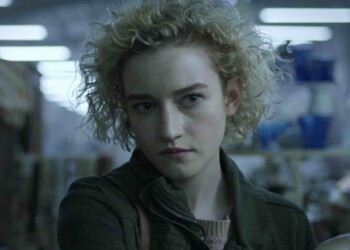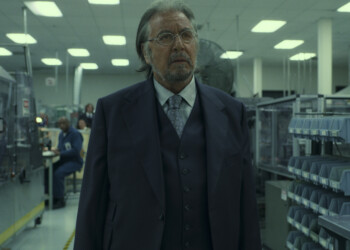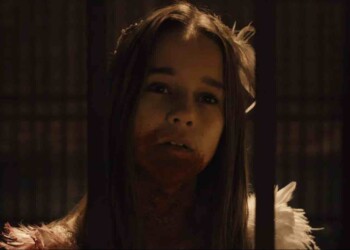In the latest edition of Send the Ravens, we do a deep dive into the song that closed the most recent episode of ‘Game of Thrones and a journey into the crypts of Winterfell…
By Damon Martin — Editor/Lead Writer
‘Game of Thrones’ hasn’t always been completely faithful to the source material written by George R.R. Martin but the series still manages to pluck out important pieces of history that is interwoven into the universe created in ‘A Song of Ice and Fire’.
The latest example of this was the just of ‘Jenny’s Song’ in the last episode titled ‘A Knight of the Seven Kingdoms’.
Upon request from Tyrion Lannister after a night filled with drinking, stories and Ser Brienne of Tarth being knighted, the Hand of the Queen requests a song but no one seems willing to sing. That’s when Tyrion’s former squire Podrick voices up and sings a haunting tune called ‘Jenny’s Song’ — or the version of the song in the show is called ‘Jenny of Oldstones’.
Now part of the lyrics from the song come directly from the books ‘A Storm of Swords’ and ‘A Feast for Crows’ but the rest were written specifically for this scene. Part of the lyrics go like this:
“High in the halls of the kings who are gone
Jenny would dance with her ghosts
The ones she had lost and the ones she had found
And the ones who had loved her the most
The ones who’d been gone for so very long
She couldn’t remember their names
They spun her around on the damp old stones
Spun away all her sorrow and pain
And she never wanted to leave.
Never wanted to leave
Never wanted to leave”
The story of Jenny of Oldstones relates back to ‘Game of Thrones’ in several different ways when compared to the current stories happening in the final season.
Jenny of Oldstones was a lovely girl from the Riverlands, who met crown Prince Duncan Targaryen when he was traveling through the area more than 50 years before the events that take place in ‘Game of Thrones’. Duncan was in the line of succession to become the next king after his father, Aegon V Targaryen, was finished ruling.
Duncan fell madly in love with Jenny, who claimed to be a direct descendant of the First Men who came to Westeros thousands of years earlier. Duncan decided to marry Jenny against the wishes of his father, who had betrothed him to the daughter of Lord Lyonel Baratheon, Lord of Storm’s End. Aegan V was the first Targaryen king to break against the tradition of marrying siblings together to keep the bloodlines pure and he had promised his first born son to the Baratheons as a way to forge new allies in the Seven Kingdoms.
Duncan refused to give up Jenny and eventually he was given an ultimatum — annul his marriage to Jenny or give up the Iron Throne. Duncan decided to stay married to Jenny and he abdicated his right to become the next Lord of the Seven Kingdoms.
Duncan marrying Jenny and breaking his vows to Lyonel Baratheon’s daughter also caused the Lord of Storm’s End to launch an uprising against the crown. The brief rebellion was quickly stamped out by the Targaryen forces but Duncan’s marriage to Jenny ultimately forced his father Aegon to send his daughter Rhaelle to Storm’s End to marry Lyonel’s heir, Ormund Baratheon.
Duncan abdicating the throne to marry Jenny also meant that his younger brother Jaehaerys Targaryen would now be the next in line to sit on the Iron Throne. Both Jaehaerys and his sister Shaera were also betrothed to marry children from the other great houses of Westeros but much like Duncan they refused.
Instead, Jaehaerys and Shaera fell in love with each other and ultimately the brother and sister married in a secret ceremony, which once again left Aegon to deal with the angry houses they spurned by breaking their vows. Aegon’s final son Daeron Targaryen also fell in love with a woman he intended to marry, which once again broke another vow made by his father. Aegon ultimately allowed his sons to marry for love because he had been allowed to do the same by his father.
Four years after Jaehaerys and Shaera’s wedding, they had two children — Aerys and Rhaella Targaryen.
It was during this time that Jenny of Oldstones, now referred to as Lady Jenny, brought a wood’s witch with her to the court where she offered prophecies to the future king. Jenny had been friends with this wood’s witch for some time and she claimed to be one of the Children of the Forest but that was unlikely.
What the wood’s witch prophesized was that someone in the bloodline of Aerys and Rhaella would become the ‘prince that was promised’ — the mythical hero who would save the Seven Kingdoms from another ‘Long Night’ where the world would be plunged into darkness. To ensure that this prophecy came true, Jaehaerys ordered his son and daughter to marry each other, against their wishes, so the bloodline would stay pure and they would eventually produce the ‘prince that was promised’.
Now if the name Aerys sounds familiar that’s because he would eventually become King Aerys II Targaryen better known as ‘The Mad King’.
Following Aerys and Rhaella’s marriage several years later, they were expecting their first born child and King Aegon called for a massive celebration at the Targaryan summer retreat called Summerhall.
In his later years, King Aegon had become obsessed with rebirthing dragons into the world after they had gone extinct. Aegon researched all sorts of different ways that he could potentially hatch a dragon egg and birth one of the great beasts back into the world.
At Summerhall, Aegon and his family including his eldest son Duncan and his wife, Jenny of Oldstones, had gathered for this celebration. That’s when a great fire broke out inside the castle and numerous people perished including King Aegon, Duncan and his wife Jenny. The Tragedy of Summerhall coincided with the birth of Aerys and Rhaella’s first child, Rhaegar, being born the same day.
Aerys, Rhaella and Rhaegar all survived along with the wood’s witch, who was there as a guest of Jenny but the king, his oldest son and his wife were all dead.
There were rumors that the tragedy occurred because King Aegon had attempted to hatch dragon eggs by using wildfire and it got out of control, ultimately burning down the castle and killing much of the royal family. There’s no proof to those claims but that was a theory that circulated, which would explain how the fire broke out during the celebration.
With King Aegon dead, his son Jaehaerys ascended to the throne and his reign was short — only three years — before his son Aerys II Targaryen would take his place. As we all know, Aerys would eventually become ‘The Mad King’ and he would be the last Targaryen to sit on the Iron Throne.
Now circling back to Jenny of Oldstones, her story somewhat mirrors that of both Robb Stark, who married a common woman rather than the daughter of Walder Frey as he had been betrothed, which ultimately led to ‘The Red Wedding’. It also somewhat mirrors a storyline currently taking place with Jon Snow and Daenerys Targaryen.
Jon is the rightful heir to the Iron Throne but he may abdicate his claim in favor of the woman he loves, Daenerys Targaryen much like Duncan did when he fell in love with Jenny.
The other piece of the puzzle comes from Jenny’s friend, the wood’s witch, who told the king of the prophecy that the ‘prince that was promised’ would come from bloodline of Aerys and Rhaella. Those two would be parents to Rhaegar Targaryen, who is Jon Snow’s father and they were also the parents to Daenerys Targaryen as well.
That means once again that the prophecy of ‘the prince that was promised’ could be either Jon or Daenerys as it’s been expected since Melisandre mentioned the possibility last season.
There are a million other possibilities how this all ties together including part of the ‘prince that was promised prophecy’ that says this savior will ‘bring the dawn’ and his or her song is a ‘song of ice and fire’. Now that could be a literal meaning of an actual song — but more likely it’s the marriage of ice and fire, which could mean Stark and Targaryen thus once again pointing the finger at Jon Snow, who is the son of Rhaegar Targaryen and Lyanna Stark.
It’s an interesting twist in the season with this song being included and beyond Podrick’s version on the show, a full version recorded by Florence and the Machine was also released.
With that said, let’s get to your questions about ‘Game of Thrones’ this week…
How are the people in winterfell not concerned with hiding in the crypts considering the night king raises people from the dead. Dead people are in there. Maybe he can only raise the ones he kills himself? #SendtheRavens
— Brad Evans (@bradevans19) April 23, 2019
I’ve received variations of this same question all week since the last episode of ‘Game of Thrones’ ended. In that episode, quite a lot was made about the women, children and people who cannot fight being put into the crypts beneath Winterfell because it will be the safest place for them to survive the war outside. Then again, the people in the crypts will be surrounded by the bodies of dozens of long gone Starks, who have been buried there for centuries and the Night King has a way of bringing the dead back to life under his command.
Now this theory has definitely been floating around for a while now, especially considering the attention being paid to those crypts in the last episode. It seems rather ominous that they would mention the crypts so much without at least part of the story taking place there once the fighting begins outside the walls of Winterfell.
The crypts of Winterfell contain the past Kings in the North and the Lords of Winterfell who have died. Ned Stark broke that tradition when he buried his sister Lyanna and his brother Brandon in the crypt after their deaths. Now Ned Stark’s final resting place is in that crypt as well.
The crypts go back thousands of years to when Bran the Builder first erected Winterfell — and he’s the same person supposedly responsible for building the Wall after the first war with the White Walkers ended.
The crypts are cavernous and huge — larger than the whole of Winterfell — although it’s not clear how big this space might be on the show.
The idea that continues to gain steam ahead of this episode is that the Night King or the White Walkers could raise the dead, thus bringing the corpses of the Starks back to life to wreak havoc down in those crypts that are supposedly the safest place to be. There’s a cutaway line in the trailer for this episode where Daenerys even says ‘the dead are already here’, which could mean the dead rising from their graves in the crypts.
The only problem is this — we don’t know exactly what kind of powers the Night King has to raise the dead. Can he only reanimate the corpses of those he or his minions have killed? Or can he actually bring anybody dead into his service against the living?
That’s the biggest question going into this episode but it certainly seems possible that a threat will arise in those crypts during the fight. As far as who is down there, we know that there are dozens of Starks from the past but more recently, the bodies of Ned, his father, brother and sister are buried there. While statues may have been erected, it’s unlikely that either Robb Stark or Catelyn Stark are buried there after their bodies were disposed of after the Red Wedding. Remember, Robb Stark was beheaded and the head of his dead direwolf was placed on his body.
The trailers have shown Arya Stark running through the crypts, which would seem to be during this fight against the army of the dead.
Whether it’s the dead Starks or just some secret entrance that allows the dead to enter the crypts, it seems unlikely that the people down there are as safe as they are supposed to be.
What is the story of the Lord of Light and bringing people back to life?
— Black Notion (@cllosmith13) April 23, 2019
The Lord of Light, also known as R’hllor, is the god of a religion that doesn’t have many followers in Westeros but is a very popular faith across the narrow sea. The followers of the Lord of Light believe that their god is locked in an eternal battle with the Great Other, who is the lord of darkness, night and death.
The followers of the Lord of Light believe that he/she is the god of light and life, which begins to speak towards the resurrections that have been performed in his/her name.
Thoros of Myr, who died last season after being mauled by an ice bear, was one of the red priests living in Westeros trying to spread the word of the Lord of Light during the time of ‘The Mad King’ Aerys II Targaryen. Thoros eventually teamed up with the Brotherhood without Banners, who we’ve met several times over the course of the show.
When Thoros’ friend Beric Dondarrion was killed in battle by ‘The Mountain’ Gregor Clegane, he administered the last rites of the followers of the Lord of Light in a ceremony called ‘the last kiss’. The tradition is essentially a funeral ritual for the Lord of Light’s followers where they recite a prayer and breathe fire into the mouth of the deceased.
The first time that Thoros performed this ritual on Beric following his death ended up with his friend being miraculously resurrected and he credits this to the Lord of Light literally breathing life back into his body. Thoros would go onto resurrect Beric several more times, including after he was defeated by ‘The Hound’ Sandor Clegane several seasons ago.
Obviously we know that Melisandre performed this same ritual that brought back Jon Snow after he was stabbed repeatedly by his brothers in the Night’s Watch.
So what brings these people back to life?
That’s a question with no real answer unfortunately but it’s all attributed to the Lord of Light, who is seen as the god of light and life itself. The followers of the religion believe fire is life, which is why so many of their rituals involve flames of some sort. The Lord of Light seems to have a purpose for the people he or she has brought back so it’s safe to say that both Beric and Jon Snow will have important roles to play in this upcoming war.
The prophecy about the ‘prince that was promised’ also largely comes from the followers of the Lord of Light as well.
1/
Couple thoughts
1. Are the living aware the Night King has a dragon? Obviously Tormund and Beric know, but it seems like I’m any of their battle plans, no one mentions an Undead Dragon being a threat.
2. Who is Arya running from in the preview for next week? What scares Arya?— Alex (@AlexLongScott) April 23, 2019
Yes at the start of the first episode of the season, Bran pauses the meet and greet with Daenerys to inform them that the Night King has her dragon and that he’s broken through the Wall and the army of the dead is making their way south towards Winterfell.
Now how exactly they plan to combat the dead dragon, that remains to be seen.
I love these last 2 episodes. They’re perfect to me. However why does it feel like the characters in the show are brushing off the fact that Bran can fuckin see the future?!?!?!? Like wouldn’t that be insane to them?!
“Oh Bran’s just foreseeing the future again, no biggie.”— Erickuda (@LarvaCunt) April 22, 2019
Technically the Three-Eyed Raven aka Bran Stark is both a warg and a greenseer.
A warg as we’ve seen from past seasons is a person with the ability to cast their mind into an animal or in some extreme cases a person as Bran Stark was able to do with Hodor many times.
A greenseer is a person who can see visions of the past and rumors that they can also see into the future. These visions are said to materialize as dreams but that doesn’t always seem to be the case with the version of this power on ‘Game of Thrones’.
Here’s where I’m going to throw a wrinkle into Bran’s powers…
Based on what we’ve seen on the show, Bran can stare into the past and even transport himself there as we’ve witnessed when he’s gone back to Jon Snow’s birth and from the time he accidentally warged into Hodor and caused the mental break from the present into the past when hearing the worlds ‘hold the door’.
What we haven’t seen, however, is that Bran can travel into the future, although he may see flashes of future events in some of his dreams.
When he travels to visit the Night King in one of his visions, that is during the present day. When he travels back to see Rhaegar and Lyanna’s wedding, that is in the past.
In one moment where Bran gets a flood of visions in his head, we see things like his fall from the tower when he was paralyzed and Jamie Lannister killing ‘The Mad King’, which is obviously in the past. There is one clip sprinkled throughout, however, that shows wildfire containers exploding, which would seem to point towards the season 6 finale when Cersei blew up the Great Sept of Baelor. In other words, those brief glimpses could be visions of the future but again they were so quick it’s impossible to tell for certain if that’s what Bran was seeing.
The larger point here is that if Bran can see into the future, it’s only through brief glimpses in his visions and how he interprets them are unknown. Based on last week’s episode, Bran has no idea if dragonfire can kill the Night King, which speaks to the limitation of the knowledge he has hidden inside his head as the Three-Eyed Raven.
The next episode of ‘Game of Thrones’ promises to be a good one clocking in at 82 minutes, the longest of the entire series. Don’t forget to come back for our recap on Sunday night and another Send the Ravens column next week!






